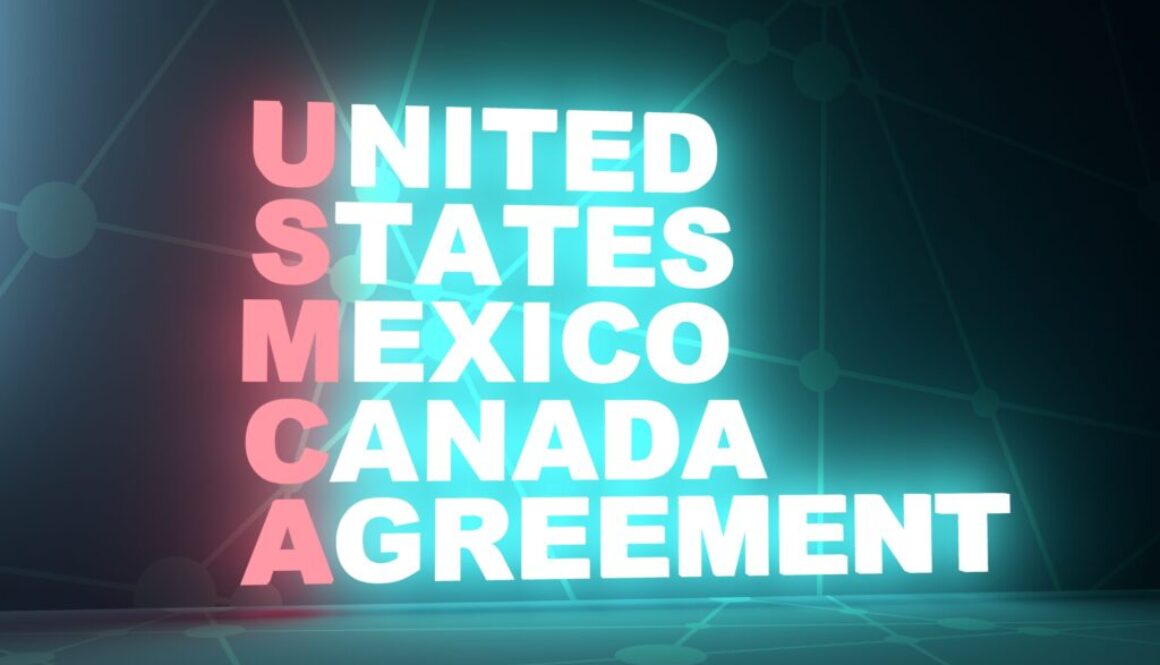The USMCA Free Trade Treaty at One Year: An Overview of Results
Mexico’s membership in the USMCA Free Trade Treaty region has underpinned the country’s economic recovery, which has been largely driven by the solid growth experienced by the United States.
The Organization for Economic Cooperation and Development (OECD) predicted that Mexico will grow 5 percent of GDP during 2021, and not at the lower figure of 4.5 percent as it was estimated at the beginning of the year.
- The advancement of the vaccination process in the country has made it possible to reactivate economic activity gradually; as well as has driven the favorable performance of Mexican foreign trade.
- In May 2021, Mexico’s total foreign trade registered a considerable increase; Exports rose 125 percent, Imports increased 87 percent. This was compared to the same month in 2020, according to Mexico’s national statistics agency, Inegi.
- Mexico’s economic recovery has been driven by strong growth in the United States economy.
- The USMCA Free Trade Treaty has been a key element in facilitating this recovery because it gives legal certainty to trade and investments in the three-country region.
- The USMCA has continued to strengthen economic relations between the United States, Mexico, and Canada.
- Mexico has positioned itself, once again, as the main commercial partner of the United States; 80 percent of Mexican exports are directed to its neighbor to the north.
- From January to April 2021, total trade in goods between the US and Mexico totaled US $ 206.8 billion. This dollar amount represents an increase of 19 percent compared to the same period in 2020, according to United States Census Bureau statistics.
- The aforementioned figure signifies that there is more trade in the region despite the slowdown in commercial exchange in many regions of the world that resulted from the pandemic.
- The coordinated work between the three countries and their respective government agencies throughout this year has allowed Mexico to advance in the implementation of the Treaty.
- The First Meeting of the Free Trade Commission of the USMCA convened in Mexico thanks to the efforts of the Ministry of Economy and the Senate of the Mexican Republic through the Monitoring Commission of the USMCA Free Trade Treaty.
- The environmental obligations and the provisions related to the implementation of the labor reform in Mexico remain pending.
- It is positive to test the Rapid Response Mechanisms of the USMCA provided for in Chapter 23 of the Treaty, through the requests presented by the United States on alleged cases of denial of labor rights in specific manufacturing facilities.
- The first Public Session of the Treaty Labor Council has been successfully completed.
- Mexico should redouble its efforts to guarantee compliance with labor obligations so that Mexican workers benefit and will help create optimal conditions to attract foreign direct investment.
- Mexico should take advantage of opportunities offered by the USMCA and the growing interest of international investors to diversify and expand their presence in destinations with less risk exposure to potential disruptions in the future.
- Mexico can take advantage of the process of reordering supply chains at a global level and the shift towards more localized production of material inputs.
- Mexico must take advantage of its strategic position vis-à-vis China and its main competitors and consolidate itself as an attractive destination for investment.
- It is necessary to ensure that the rule of law is respected and to allocate sufficient resources for the development of strategic infrastructure based on the comparative advantages offered by Mexico. Such areas include the transport and energy sectors, especially in the south-southeast region of the country.
- An agreement was signed on June 28 between Mexico and the state of California to streamline the most important infrastructure initiatives on the border, such as the project for the construction of a new mixed-vocation border crossing in the Tijuana-San Diego region.
- The decision to reactivate the High-Level Economic Dialogue between the United States and Mexico within the framework of the USMCA Free Trade Treaty will allow the alignment of economic and commercial priorities that are defined in the accord, thereby strengthening confidence and facilitating US investments in Mexico with an emphasis in the south-southeast region.
- In the LXV legislature, Mexico will give priority to reforms that strengthen governance and democracy in the country.
- From the Senate, elected officials will continue their efforts for the correct implementation of the USMCA a crucial instrument for a complex and multidimensional trilateral and bilateral relationship.
- The commercial field is one of the most positive aspects of the Treaty. The biggest challenge ahead is to find the common ground so that efforts in different areas such as migration, cooperation, and security have multiplier effects.
- Mexico has once again positioned itself as the main trading partner of the United States, with a 14.7 percent share of that country’s world trade. This is ahead of both Canada and China.
- From January to April of this year, total trade in goods between that the US and Mexico totaled 208 thousand 642 million dollars, an increase of 19 percent compared to the same period in 2020, according to data from the United States Census Office. United.
- Trade with Mexico represented 14.8 percent of the United States’ global trade between January and April 2021. This figure surpassed Canada with 14.4 percent, China 14 percent, Japan 4.8 percent, and Germany 4.5 percent.
- In general terms, the accumulated deficit in the United States trade balance grew 37.2 percent in the same period.
- The United States is the main investor in Mexico. From January 1999 to December 2020, the investment of the United States amounted to US $284 billion. This value represents 46.8 percent of the accumulated FDI in that period.
- Mexico is Canada’s third-largest trading partner.
- Canada was the third investor in Mexico from January 1999 to December 2020, with approximately US $50 billion This figure represents 7.4 percent of the accumulated FDI in that period.
- Mexico’s integration into the USMCA region has underpinned the country’s economic recovery, which has largely been boosted by the solid growth sustained by the United States economy.
- The data show that with the USMCA there is more trade in the region despite the slowdown that international commerce has experienced in many regions of the world as a result of the pandemic.
- The successful conclusion of the First Meeting of the Free Trade Commission of the USMCA, together with the commitments emanating from the First Meeting of the Committee on the Environment and the Labor Committee of the USMCA, is a reflection of the correct functioning of the channels for the institutional provisions of the Treaty.




